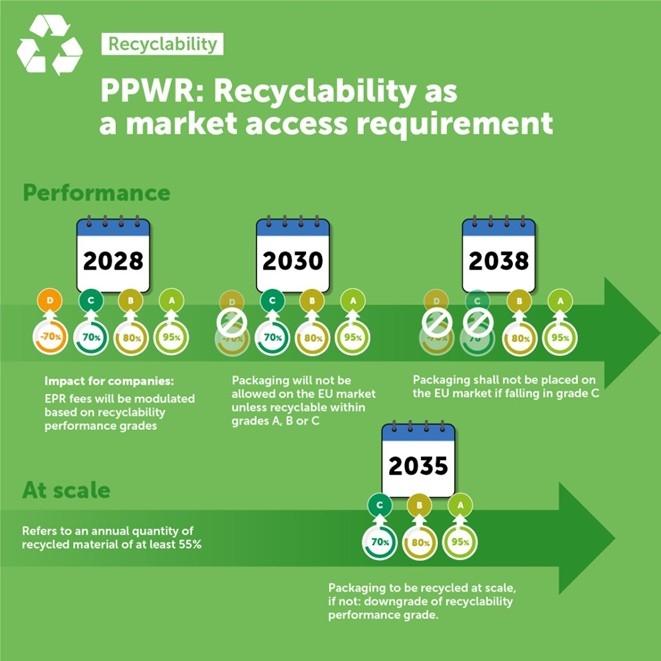PPWR Insights 1 - What do the new recyclability requirements mean for your business?
The Packaging and Packaging Waste Regulation (PPWR) introduces strict new recyclability requirements for all packaging placed on the EU market. In this blog, we will take a closer look at these requirements, how and when they will be defined, and how they will affect packaging design.

When is packaging considered recyclable?
From 2030 onwards, all packaging must be designed for recycling, ensuring it can be processed into secondary raw materials of sufficient quality to replace virgin materials.
Packaging is considered recyclable when it:
- is designed for recycling and meets certain quality standards.
- can be collected separately, sorted efficiently and recycled at scale (from 2035 onwards).
- meets performance grades (A, B or C) for recyclability, which will become stricter over time (from 2038, only grades A and B will be allowed).
By 2028, the European Commission is to develop detailed and standardised criteria for the recyclability of packaging. Each type of packaging will be assigned a score based on these criteria. The criteria are still under development and are being further discussed in separate working groups (see box).
Exemptions and financial incentives
Certain packaging types, including packaging for medicines and baby food, are temporarily exempt. Innovative packaging solutions that do not yet meet the new recyclability criteria may be placed on the market for a maximum of five years, provided there is a clear roadmap to full compliance.
As of 2030, Extended Producer Responsibility (currently Green Dot) fees will be adjusted according to each packaging item’s recyclability score. This means that producers will pay higher fees for hard-to-recycle packaging and reduced fees for materials with superior recyclability.
What does "recycled at scale" mean?
By 2030, the EU is to introduce a methodology to assess whether packaging is actually recycled at scale. This will be based on the effective recycling rates for each packaging material, monitored using a transparent tracking system. The PPWR introduces a phased approach: the design-for-recycling criteria reflect theoretical recyclability, while the “recycled-at-scale” criteria ensure that materials are actually recycled in practice across the European Union. The deadline for this has been set at 2035.
However, it remains unclear whether a material group that is not widely recycled by 2035 will be banned from the market – as a strict interpretation of the text suggests – or whether it will simply receive a lower recyclability score.
What are the next steps?
The recyclability criteria for each material are currently being developed within CEN (European Committee for Standardisation). Expert working groups are drawing up so-called traffic light tables to assess the recyclability of each material type. The system classifies packaging into the following categories:
- Green – Encouraged packaging
- Yellow – Tolerated but not ideal
- Red – Banned from the market
The assessment considers, among other factors, how packaging components behave in sorting facilities. For example, a polystyrene yoghurt pot is assessed together with its sealing film and wrapper, as these typically end up together in sorting centres. Components are assessed separately only if, in more than 80% of cases, they are removed by consumers before sorting.
Fost Plus is closely following developments in two specific working groups: WG10, which defines the criteria for plastic packaging recyclability, and WG3, which does the same for materials such as paper/cardboard, glass, aluminium and metal.
The technical specifications for WG3 will be finalised by the end of 2025 and subsequently submitted to the European Commission, likely by April 2026. For WG10 (plastics), the first drafts will be published in November 2025 and will then be available for purchase. This will be followed by a revision period of approximately 1.5 to 2 years, during which updates to the drafts will be made by the CEN working groups, taking into account the state of the art in collection, sorting, and recycling, as well as innovations in the packaging sector.
How can you stay informed?
You will find the latest information about PPWR on the PPWR page on our website. Fost Plus members can contact Customer Service or their Account Manager if they have any questions.
